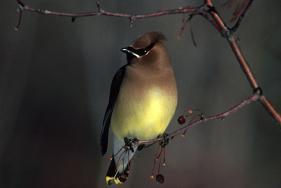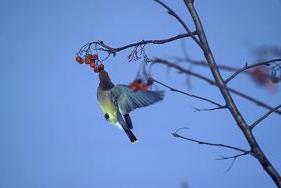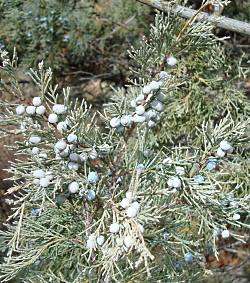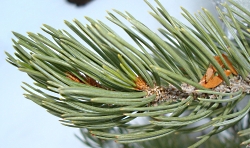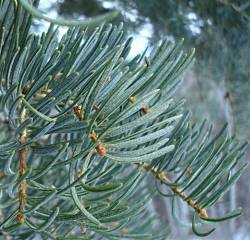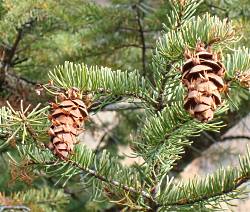
Click map for larger view
Map by H. Strand, Data from
Blackett and Wakefield 2002.
Hi, I’m Holly Strand from Stokes Nature Center in beautiful Logan Canyon.
Cold weather getting to you? Can’t swing a trip to Hawaii or the Carribean this year?
Fortunately for us, there’s a natural antidote to winter right here in Utah Hot springs abound in the Beehive State. According to a Utah Geological Survey database, there are 106 known springs with waters above 25 degrees Celsius or 77 degrees Fahrenheit. The hottest temperature recorded in a Utah spring is 91 degrees Celsius or 195 degrees Fahrenheit at Crystal Hot Springs in Salt Lake County.
Hot springs develop when rain and melted snow infiltrate into the ground. This ground water then sinks deep enough to be warmed by the heat contained in the earth’s interior. Because hot water is less dense it is pushed back to the surface by the continued sinking of incoming heavier, cold water. Replenishment through surface precipitation creates a continuous cycle.
Why do some areas have hot springs and others do not? While there is heat in the earth beneath any spot on the surface, in some areas, this heat is concentrated closer to the surface. For instance, in and around volcanoes–this is the case in Yellowstone area.
Luckily, we don’t know of any volcanoes lurking beneath us. But we know that the Basin and Range area of western Utah, southeastern Idaho, Nevada and eastern California, is expanding or spreading. This spreading movement leaves a relatively thin crust. And a thinner crust means heat is closer to the surface. Furthermore, crustal movement create surface faults that allow cold water to seep down and warm water to flow out. Thus with few exceptions, the higher temperature geothermal areas in Utah occur either in the Basin and Range Province or within the Basin and Range-Colorado Plateau transition zone.
Geothermal sources have many practical uses. The Blundell power station at the Roosevelt Hot Springs geothermal area near Milford produces commercial energy. There are several greenhouses and aquaculture facilities in Utah using geothermal resources. But my favorite application of geothermal waters would be the hot spring spa or swimming pool. Soakersbible.com lists 16 of these in Utah. And for those of us in northern Utah there’s at least ten more right across the border in Idaho.
For maps and sources of information on hot springs and spas, see Wildaboututah.org.
Thanks to the Lion’s Gate Manor in Lava Hot Springs for supporting research and development of this Wild About Utah topic.
For Wild About Utah and Stokes Nature Center, I’m Holly Strand.
Credits:
Images: Map by H. Strand, Data from Blackett and Wakefield 2002.
Text: Holly Strand, Stokes Nature Center
Sources & Additional Reading:
Blackett, R.E., and Wakefield, S.I., 2002, Geothermal resources of Utah, a digital atlas of Utah’s geothermal resources: Utah Geological Survey, OFR-397, CD-ROM. Available online https://www.geology.utah.gov/emp/geothermal/wells_springs_database.htm [accessed January 10, 2010]
Blackett, R.E. Utah Geothermal Wells & Springs Interactive Map. 1:500,000. Utah Geological Survey, Cedar City Office. https://www.geology.utah.gov/geothermal/interactive/index.html. [ accessed January 10, 2010]
DeTar, R.E. Thermal Waters. Digital Atlas of Idaho. https://imnh.isu.edu/DIGITALATLAS/ [ accessed January 10, 2010]
Oregon Institute of Technology. Geothermal Resources of Utah. Geo-Heat Center Quarterly Bulletin Vol. 25. No. 4. https://www.oit.edu/docs/default-source/geoheat-center-documents/quarterly-bulletin/vol-25/25-4/25-4-bull-all.pdf [ accessed January 10, 2010]
Utah Geological Survey. Geothermal Occurrences in Utah. https://www.geology.utah.gov/emp/geothermal/geothermal_occurrences_in_utah.htm
Travel:
Lion’s Gate Manor in Lava Hot Springs. (208) 776-5118 https://www.lionsgatemanor.com/index.html
Geothermal Springs in Idaho, https://www.energy.idaho.gov/renewableenergy/recreation.shtml

